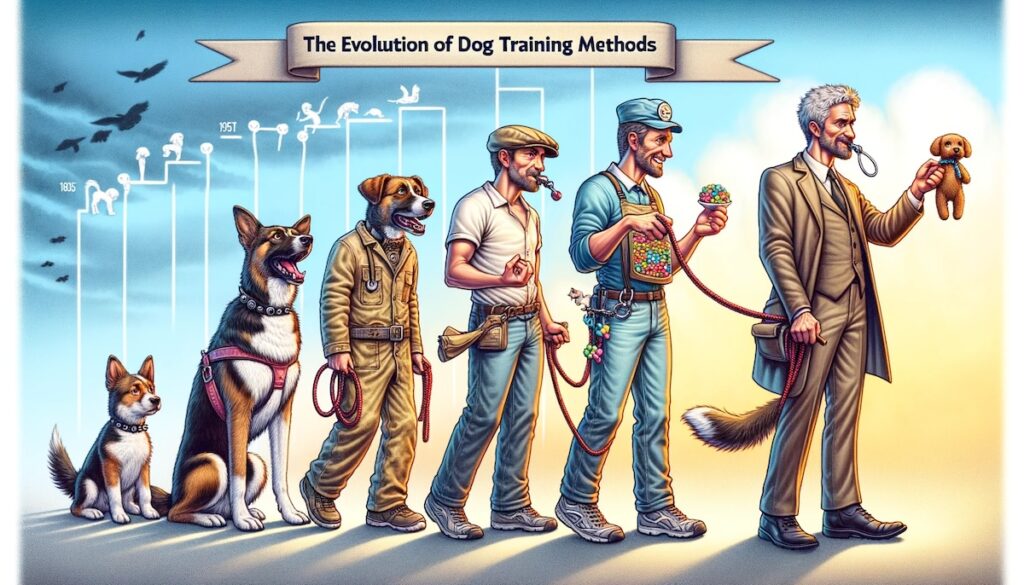1. The Evolution of Dog Training Methods
For centuries, dog training relied heavily on punishment, force, and fear to get desired behavior and curb unwanted behaviors. Methods included physical punishment like hitting dogs or jerking choke chains when they disobeyed. These confrontation-based techniques stemmed from a belief that dogs required harsh corrections to learn proper manners.
In the early 20th century, the most popular dog training methods and tools were choke chains, prong collars, and shock collars. Trainers employed “dominance theory,” asserting the need to establish yourself as the “alpha” over your dog through physical dominance and punishment. This philosophy condemned anything perceived as “coddling” or “spoiling” dogs, like providing affection or comfort.
However, by the 1960s, scientific discoveries transformed our comprehension of animal learning. B.F. Skinner’s research demonstrated that behaviors can be modified through their consequences, known as operant conditioning. Behaviors followed by a rewarding outcome become more likely to recur, while those met with punishment diminish in frequency.

This understanding enabled traditional dog training, to shift towards more humane, science-based techniques. Pioneers like Karen Pryor and Dr. Ian Dunbar popularized the use of positive reinforcement, whereby desired dog behaviors are rewarded to increase their reoccurrence. Food treats, toys, and praise became favored tools to mark and encourage wanted actions from dogs.
Today’s dog training landscape offers two broad approaches:
Reward-based – Relies on positive reinforcement and negative punishment
Aversive-based – Uses positive punishment and negative reinforcement
Despite the rise of reward-based popular dog training methods now, some trainers maintain the use of confrontation and pain through tools like prong collars or shock collars. However, scientific evidence increasingly shows serious welfare concerns with aversive-based dog training approaches.
2. The Damaging Impacts of Aversive Training
A growing body of research systematically documents the negative behavioral and physiological effects of aversive training methods on dogs. Key findings demonstrate elevated markers of stress and compromise welfare.
Behavioral Indicators of Stress
Studies tracking dog behavior during and after training find increased stress signals in response to aversive methods. Documented signs of behavioral stress include:
Heightened shaking, yawning, or lip licking
Avoidance behaviors like lowered postures, retreating, or hiding
Tail tucked, ears back – signs of fear/anxiety
Increased barking, whining, or yelping
These reactions indicate that techniques like leash corrections or shocks induce acute stress. Their frequency escalates in proportion to the level of confrontation or pain experienced by dogs.
Detrimental Physiological Effects
In addition to external behavioral responses, aversive methods cause internal physiological changes associated with stress, including:
Elevations in the stress hormone cortisol following training
Increased heart rate variability and blood pressure
Activation of the sympathetic “fight or flight” nervous system
The use of physical or verbal punishment triggers a sudden spike in arousal and anxiety. Over time, this can dysregulate a dog’s cortisol production and cause chronic stress.
Long-Term Welfare Threats
Furthermore, the stress of aversive training extends beyond discrete training interactions. Collateral harm includes:
More negative emotional states and perceptions of the environment
Development of fearful, aggressive, or anxious behaviors
Disruption of the human-animal bond and relationship quality
Repeated exposure to confrontation and pain impacts long-term behavior, mood, and quality of life. This compromises welfare outside of training contexts.
3. The Welfare Benefits of Reward-Based Dog Training methods
In contrast, a bounty of scientific evidence demonstrates the advantages of reward-based training for enhancing dog welfare across metrics like:
Lower Stress Signals
Dogs trained using rewards show markedly lower frequencies of behaviors indicative of stress or anxiety. Benefits include:
Minimal avoidance behaviors or panting
Relaxed facial expressions and body postures
No spikes in physiological indicators like cortisol
The absence of confrontation or pain prevents the acute stress response generated by aversive methods.
Stronger Dog-Owner Relationships
Reward methods also cultivate stronger bonds between dogs and their human handlers. Advantages encompass:
Increased focus and engagement with owners
Enhanced ability to read human social cues
Greater owner satisfaction and perception of success
Positive reinforcement training revolves around communicating clearly and consistently with dogs. This cooperative approach strengthens relationships and trust.
Real World Success Stories
The effectiveness and welfare benefits of reward-based training translate to tangible successes including:
Guide, hearing, and service dogs achieving high levels of performance
Improved manners and socialization for family pets
Humane treatment of shelter dogs to improve adoptability
Rehabilitation of fearful, anxious, or aggressive dogs
Organizations like the Academy for Dog Trainers and CCPDT certify trainers in these empirical, science based training ethical methods to promote animal welfare.
4. Lasting Impacts: How Training Methods Shape Dog Behavior and Emotion
The influence of the training method extends well beyond discrete teaching interactions. Research comparisons affirm substantial differences in how reward vs. aversive methods impact long-term dog behavior, emotion, and welfare.
Assessing Behavioral States
Observational assessments reveal divergent behavioral states in dogs trained with different methods:
Dogs trained with aversives show more tension, lowered postures, and avoidance outside of training contexts
Reward trained dogs demonstrate more relaxed, social, and engaged states across various environments
Their body language indicates aversion to unwanted behavior associated with past coercive training even when no correction is imminent.

Cognitive Bias Tasks
Cognitive bias tests also highlight emotional differences based on training history:
Dogs trained with confrontation make more pessimistic judgments about ambiguous stimuli
Reward trained dogs show an optimistic bias indicative of positive affect
Choices during cognitive bias tasks provide “windows” into the cumulative emotional experiences of dogs. Reward training is linked to upbeat states.
Comparative Analyses
Broader comparative research reveals better behavioral regulation and social functioning for dogs trained with rewards:
Fewer reported behavior problems in pet dogs
Higher adoption rates from shelters
Superior socialization and lower fearfulness
Analyzed holistically, the long-term effects of reward methods promote better behavioral and emotional outcomes.
5. Implementing Reward-Based Dog Training
All dog owners can successfully practice reward-based training of alpha dog by following some fundamental guidelines:
Reward-Based Training Tips
Use especially motivating treats, toys, and verbal praise to reward wanted behaviors
Time delivery of rewards to precisely mark desired actions
Reward small steps toward a goal behavior at first, then reward intermittent good behaviors
Utilize rewards to teach cues like “sit” and reinforce calm manners
Phase out food treats over time but continue rewarding with praise
Transitioning Away From Aversives
For those switching from aversive approaches, important advice includes:
Stop using all pain- or fear-based tools like prong collars, shock collars, or leash jerks
Prevent unwanted behaviors by redirecting attention rather than punishing
Never use physical corrections or intimidation like alpha rolls
Expect the transition to take patience and consistency
Expert Trainer Perspectives
Professional dog trainers offer these supplementary tips on successful reward-based dog training class too:
“Keep sessions under 10 minutes to avoid overloading dogs.” – Victoria Stillwell
“Make sure rewards are given within 1-2 seconds of the wanted behavior.” – Andrea Arden
“If your dog gets frustrated, go back to an easier step.” – Ian Dunbar
“End sessions on a positive note so your dog wants to train again.” – Kathy Sdao
6. The Future of Dog Training
Extensive scientific research demonstrates that reward-based dog training aligns with ethical imperatives to promote animal welfare, while aversive methods induce behavioral stress responses and compromise welfare.
As our comprehension of animal learning and cognition evolves, we must reexamine traditional practices that make dogs learn or risk physical or psychological harm. Leading veterinary and animal behavior organizations strongly advocate for dog training based wholly on positive reinforcement.
For contemporary dog enthusiasts, this creates a clear ethical responsibility as dog trainer. All dogs deserve humane handling and training methods that enhance their skills without cost to their welfare.

Realizing this future requires open-mindedness from modern, science based dog training professionals. As scientific evidence mounts, the dog training community must transition away from all methods relying on pain, fear, or intimidation.
Reward-based training represents a more ethical paradigm based on cooperation instead of confrontation. This relationship based training empowers us to unlock every dog’s potential through positive experiences.
7. Global Perspectives on Dog Training Techniques
While reward-based methods grow increasingly popular in many regions, training philosophies and regulations vary globally. Some patterns stand out:
Western cultures like Australia, Europe, and North America have seen the most dramatic rise of reward-based training due to extensive advocacy.
Conversely, confrontation-based methods remain prominent in parts of Asia, the Middle East, and Eastern Europe.
Norway, Sweden, and other European nations have legally prohibited certain aversive tools like shock collars.
In the EU, electric shock collars have been partially banned, with plans to fully prohibit by 2027.
Regardless of local norms, evidence-based practices must direct training decisions to prioritize dog welfare. Ongoing education can accelerate the global adoption of empirically-validated methods balanced dog training.
8. Limitations of Current Research and Future Directions
While compelling evidence supports the risks of aversive methods and benefits of reward-based training, some limitations temper our current understanding:
Most studies focus on discrete training scenarios – real world impacts need further study
Possible long-term detrimental effects of reward-based methods are unknown
Direct randomized comparisons of methods are limited
Possibility of effective use of balanced training approaches
Effects likely depend partly on individual dog characteristics
To deepen expertise, future research should investigate questions like:
How do different methods impact real-world obedience and behavior outcomes?
What determines optimal reward schedules and fades for habituation?
Do effects differ across breeds or canine personalities?
Is any proportional use of aversives justified if impacts are transient?
Broader, long-term studies will provide nuance to guidelines as the science continues evolving.
9. Conclusion
Substantial scientific evidence demonstrates that traditional dog training methodology significantly impacts canine welfare. Reward-based methods minimize stress while confrontational approaches carry risks.
This affirms an ethical obligation for dog professionals to align scientific training with empirical wisdom. All training should aim to enrich dogs’ capabilities without compromising their wellbeing.
As the dog training community evolves, science-backed methods must become the norm. With compassion and consistency, positive reinforcement offers a more ethical path forward professional dog trainer.

